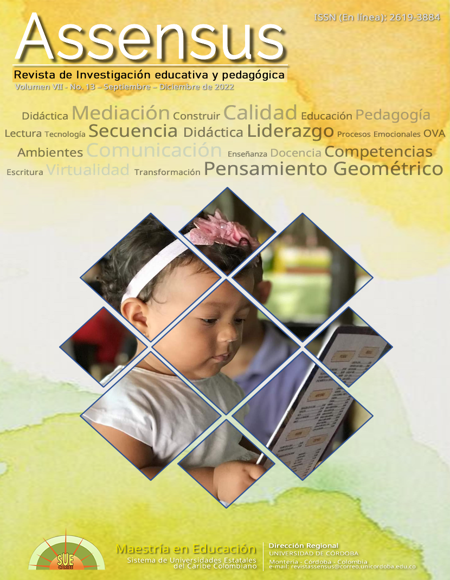Visualize, lets build the concept of Similarity
Visualizar, permite construir el concepto de Semejanza

This work is licensed under a Creative Commons Attribution-ShareAlike 4.0 International License.
The Assensus journal has a Creative Commons license. The citation, use and partial or total reproduction of the contents is authorized by citing sources. For more information, see https://creativecommons.org/licenses/by-sa/4.0/deed.en
Show authors biography
This study highlights the importance of the cognitive activity of visualization for the understanding of the concept of similarity of geometric figures, with seventh grade students at the Technical Industrial El Palmar educational institution located in Paz de Ariporo, Casanare; the low results in external tests, the insinuations that the MEN has been making in the standards and curricular guidelines of mathematics, show that there is a need to strengthen visualization as a cognitive activity necessary to recognize and analyze geometric properties, tools such as Geogebra make it possible This activity, more than a necessity, is a possibility. Design-based research (IBD) is the privileged qualitative methodology to develop this sequence that allows understanding aspects of similarity through visualization, when developing the tasks of a school technological activity whose central task is the construction of the model of a house and modeling of its parts; The initial results found show that according to the state of apprehension the child privileges the iconic visualization, since he tends to relate the representations with known objects. Focusing more on the recognition of the figure than on the identification of its properties as a consequence of the inter and intrafigural relationships, as the development of the proposed tasks continues, it can be seen that the child proposes auxiliary lines that originate a new figure passing from perceptual apprehension to surgery; When observing and analyzing the responses issued by the students, it can be seen that when they make auxiliary lines on a figure or figural representation, the qualitative properties are privileged, they go from the figure to the speech, evidencing dimensional deconstruction, favoring the non-iconic representation (Duval, 2010 ); consequently, perceptual apprehension functions as an articulating axis between the discourse and the operations that the child makes on the representations.
Article visits 285 | PDF visits
Downloads
- Bisquerra, R., Dorio, I., Gomez, J., Latorre, A., Martinez, F., Massot, I., & Mateo, J. (2009). Metodología de Investigación Educativa. Madrid: La Muralla S.A.
- Clemente, F., Llinares, s., & Torregosa, G. (2017). Visualizacion y razonamiento configural. Revista Latinoamericana de investigacion en matemática educativa, 497-516.
- Collective, D.-B. R. (2003). Design-based research: An emerging paradigm for educational inquiry. Educational Researcher, 32(1), 5-8.
- Donolo, D., & Rinaudo, M. (2010). Estudios de diseño. Una perspectiva prometedora en la investigación educativa. Revista en educacion a distancia , 1-29.
- Duval, R. (1998). Semiosis y pensamiento humano. Cali: Grupo de educación matemática.
- Duval, R. (2010). Los cambios de mirada necesarios sobre las figuras. Tecne, episteme y didaxis, 108-129. Obtenido de https://revistas.pedagogica.edu.co/index.php/TED/article/download/998/1011/0
- Duval, R. (2016). Las Condiciones Cognitivas del Aprendizaje de la Geometría. Desarrollo de la Visualización, Diferenciaciones de los Razonamientos, Coordinación de sus Funcionamientos. Bogota.
- Escudero, I. (2003). La Relación Entre Conocimiento Profesional Del Profesor De Matemáticas De Enseñanza Secundaria Y Su Práctica. Las Semejanza Como Objetivo De Enseñanza-Aprendizaje. Sevilla: Universidad de Sevilla.
- GeoGebra.org. (22 de agosto de 2022). Geogebra Para Enseñar y Aprender Matemáticas. Obtenido de https://www.geogebra.org/
- Gravemeijer, K., & Cobb, P. (2006). Design research from a learning design perspective. London: Routledge. doi:https://doi.org/10.4324/9780203088364
- Hernandez Sampieri, R., Fernandez, C., & Baptista, P. (2014). Metodología de la Investigación. México: McGrawHill.
- Lemonidis. (1991). Analyse et réalisation d’une expé-rience d’enseignement de l’homothétie. Didactique des Mathématiques, 295-324.
- Marmolejo, G. (2014). Desarrollo de la visualización a través del área de superficies planas. Análisis de libros de texto colombianos y españoles. Salamanca: Universidad De Salamanca. Obtenido de https://gredos.usal.es/bitstream/handle/10366/125728/DDMCE_MarmolejoAveniaGA_Desarrollodelavisualizaci%c3%b3n.pdf?sequence=1&isAllowed=y
- Marmolejo, G., & Vega, M. (2012). la visualización en las figuras geométricas. Importancia y complejidad de su aprendizaje. Educación Matemática, 7-32. Obtenido de http://www.scielo.org.mx/scielo.php?script=sci_arttext&pid=S1665-58262012000300002
- Marmolejo, G., & Vega, M. (2012). la visualización en las figuras geométricas.importancia y complejidad de su aprendizaje. Educaion matematica.
- Ministerio de Educacion Nacional . (1998). Lineamientos Curriculares en Matematicas . Bogota D.C: Ministerio de Educacion Nacional .
- Ministerio de educacion Nacional. (2006). Estándares Básicos de Competencias en Matematicas. Bogotá: Ministerio de Educación Nacional.
- Ministerio de Educacion Nacional. (2008). Orientaciones Generales para la educacion en Tecnología: Ser competente en tecnología: ¡una necesidadpara el desarrollo! Bogotá: Ministerio de Educación Nacional.
- Quintana, A., Paez, j., & Tellez, P. (2018). Actividades tecnológicas escolares: un recurso didáctico para promover una cultura de las energías renovables. Pedagogía y saberes, 43-57.
- Torregosa, G., & Quesada, H. (2007). coordinacion de procesos cognitivos en geometría. Revista Latinoamericana de Investigación en Matemática Educativa, 275-300.



